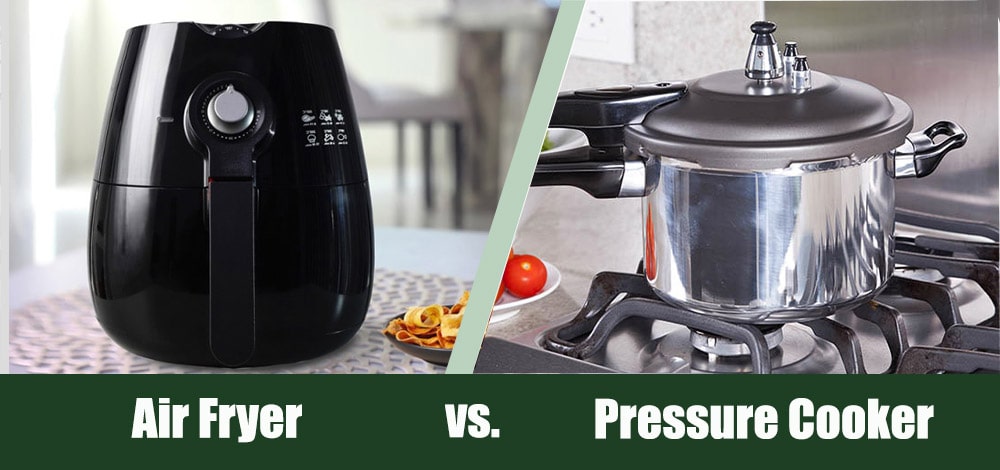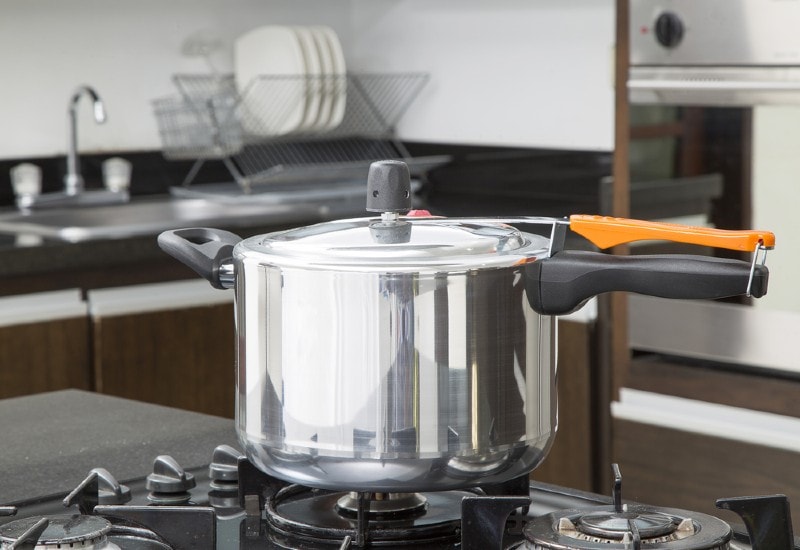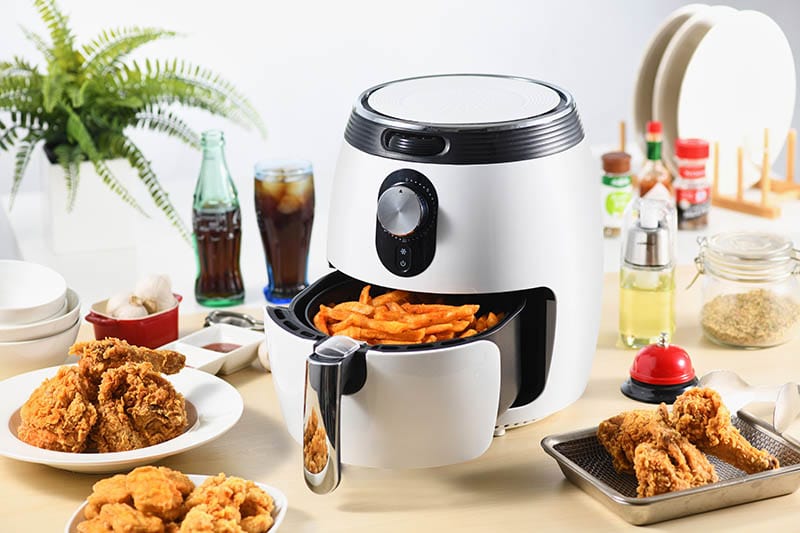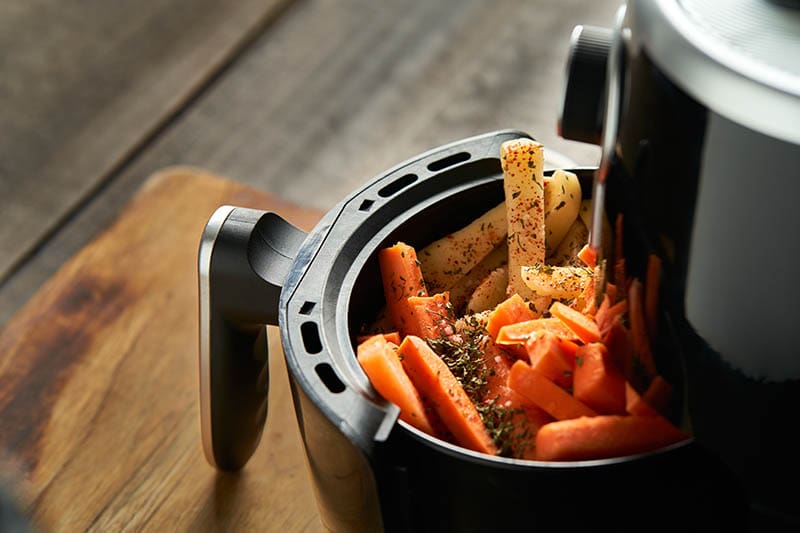Air Fryer Vs Pressure Cooker: Pros, Cons, & Differences
-
Pete Ortiz
- Last updated:

There’s no denying that our kitchen appliances have significantly evolved these past few decades. Gone are the days when we could only rely on gas ovens, stoves, or fires to prepare our meals. We currently have options that are far more energy efficient, and the air fryer is at the top of that list.
The pressure cooker is not as popular, though it also cuts down our cooking times by a significant percentage. If you’ve ever found yourself confused and wondering which cooking appliance best caters to your needs, this is the post you’ve been waiting for.
Pressure Cooker Overview

What’s a Pressure Cooker and How Does It Work?
A pressure cooker is essentially a sealed pot that has been designed to shorten the period taken to prepare slow-cooked dishes, by leveraging the benefits of high pressure. If you’re going to use a pressure cooker to prepare your meal, the foundation of that dish has to have some sort of liquid. And depending on what you’re preparing, the said liquid could be water or broth.
The chief function of the liquid is to generate steam, that is to be sealed inside that pot, to generate a predetermined degree of pressure. The entire process creates a snowball effect that culminates in an increase in temperature.
If you compare the amount of time taken to prepare a meal using a pressure cooker with that of the stove, you’ll learn that the cooker’s time period is much shorter. That’s primarily due to the fact that the pressure created as a result of trapping steam inside the pot forces the liquid to get to its boiling point faster.
The internal pressure not only affects the liquid’s boiling point but also forces the steam to penetrate the food much deeper than it would have, had you decided to use a ventilated pot. Hence, making the food cook even faster.
One of the things that you’ll quickly learn about the pressure cooker is that it’s not designed to be opened halfway through, to give you an opportunity to check whether or not your meal’s ready. You could open it if you wanted to, but that will defeat the whole purpose of using the pot—all that build-up will be released into the air, and the whole process will start from scratch.

How’s The Pressure Released?
Opening the lid of a pressure cooker before releasing all that build-up is pretty much a death sentence. And that’s not an exaggeration, seeing as various experts in the industry have confirmed that improper use of pressure cookers has in the past led to terrible injuries and even death.
Every sealed pot has a small valve designed to safely open and close an output hole. It’s through that hole that you get to gently release all the steam inside, to lower the pressure. All that pressure has to be released before opening the lid, or the lid will be blown off the cooker, forcing the pot’s contents to spill everywhere.
Given how high those temperatures are, if the liquid gets to any part of your body, you’re most likely going to incur fourth-degree burns.
How Will You Know When Your Food’s Ready?
First off, it’s important to note that we have two types of pressure cookers. You could go for the modern electric cooker, which is more convenient and practical, or the traditional kind, also known as the stovetop model. We would encourage anyone inexperienced to go for the electric cooker, as it comes with built-in heating features, digital displays, and accurate timers.
Installing a heating source in a pressure cooker was obviously a game changer, as we were all tired of having to first heat up the container, before removing it to check if the pressure or temperature was optimal.
In a nutshell, if you’re planning on cooking using a pressure cooker, don’t forget to put all your ingredients in. Once they are in, power up the appliance, and wait for the magic to happen. It’s quite frankly, one of the simplest methods of cooking any dish.
- By hastening your cooking time, it helps you save on energy bills
- Doesn’t eliminate any form of nutrient from your meal
- Reducing the cooking time means it’s highly efficient
- Ideal for large households, as it can accommodate a large amount of food
- It’s versatile since you can cook pretty much anything in it
- You won’t easily be able to confirm if the food’s ready
- Not practical for a small household
- Comes with a high price tag
Air Fryer Overview

What’s An Air Fryer and How Does It Work?
An air fryer is similar to a pressure cooker in the sense that they are both countertop cooking appliances. However, they are different in the way they operate, as the fryer is designed to use a powerful fan to circulate the hot air generated by a heating element. In retrospect, an air fryer might be more similar to a traditional oven than a pressure cooker.
It’s actually an irony that we’ve named them “fryers” considering they don’t really fry the food. Yes, the food comes out tender on the inside and crispy on the outside, but there’s little to no oil or fat involved in the process.
The original fryer was invented by Philips, and consumers were first introduced to it in 2010, at an electronics fair. You can tell that it was a success, given we now have the gadget in almost every home. The modern fryer has two designs: you can go for the one that has a cooking basket, or the design that operates like a toaster oven. Also, they all vary in weight, color, shape, and more importantly, size.
What’s The Principle Behind the Air Fryer?
Air fryers rely on convection heat to cook our foods. Convection, by definition, is the process by which heat energy gets transferred within gasses or liquids through the bulk vibration/movement of molecules. It’s a lot easier to cook using an air fryer because it hastens the cooking time and makes less of a mess in the kitchen—something that you’d really appreciate if you’ve ever tried cooking using the deep-frying method.
To ensure sufficient hot air circulates around your food, the air fryer will come preinstalled with a ceramic plate, wire rack, or perforated basket. The holes will facilitate airflow as the food cooks at around 400ºF (204.44 ºC). The moisture released as the outside parts of your food starts cooking will remain sealed in and be used to tenderize the inside.
The other advantage of the air fryer is that some of them provide preset programs for consumers looking for convenience. So, if the food that you’ll be preparing is one of the most common in a household, chances are you already have the program pre-installed in your fryer. Just place it on the basket and flip on the button. The fryer might also have digital controls, in the form of touchscreens or LEDs.

What’s The Difference Between the Single-Zone and Dual-Zone Fryer?
Both are conventional air fryers, save for the fact that the single has one cooking chamber while the dual has two cooking chambers. You’ll also find that some of the brands have included racks in the package instead of separate chambers, as they find dual-zone fryers to be less efficient.
If the food items are all crammed up in there, there won’t be sufficient circulation of air. And that’s what normally leads to uneven-cooked foods, undercooked foods, and soggy foods. Also, go for units that have wider dimensions when shopping for an air fryer. Because the wider they are, the more space the unit has for air circulation. The only downside is, they’ll end up taking more of your counter space.
What Gives Air-Fried Food a Different Taste?
Any food that’s been prepared using an air fryer will have a different flavor from that prepared using a pressure cooker because of a reaction called the “Maillard Reaction.” This reaction is chemical in nature, and also known as “non-enzymatic browning.” In the presence of hot air, the reducing sugars in your food will react with the amine, to create glycosylamine. That’s what makes the food taste different, and the browning that you get to see on the food’s surface.
- Reduces food calories
- More affordable than a pressure cooker
- Suitable for small households
- Offers versatility
- Easily replicates the taste of fried foods, without relying on oil or fat
- Hastens the cooking time
- Portable
- Easy to clean
- Not ideal for larger households
- Changes the taste of some foods
- Only uses electricity
- May overheat after prolonged use
Frequently Asked Questions (FAQs)
Are Air Fryers Healthy?
Yes, and no, because it will depend on the type of food you put in the fryer. Of course, it would be ridiculous to think processed foods such as mozzarella sticks, and chicken wings would miraculously turn into healthy foods once you heat them using this gadget. But if you’d like to prepare vegetables using the least amount of oil, or reduce the caloric content levels in certain foods, then using the air fryer is the healthiest option.
Do Air Fryers Cook Faster Than Pressure Cookers?
This will again depend on several other factors, but most importantly, the model being used. However, in most cases, it’s safe to assume the fryer cooks faster than the pressure cooker, seeing as you have to get the cooker’s pressure to a certain level before it starts cooking the food.
Are Air Fryers Safer Than Pressure Cookers?
We’ve used many different models of air fryers, so we can say with certainty that they always come with incredible built-in safety features. The only problem that we have with them is how hot the exterior gets after prolonged use. That high temperature can be a big deal if you have a toddler running around in the house.
The pressure cooker, on the other hand, is riskier for anyone who’s never used one before. And if for some reason the valve or sealed gasket malfunctions, the repercussions can be dire. That’s why we are always reminded to properly care for and maintain it.
Comparison Table
| Pressure Cooker | Air Fryer | |
| Capacity | Large quantities of food | Small quantities of food |
| Energy Efficiency | Energy efficient | Energy efficient |
| Design | Electric or Stovetop | Only Electric |
| Price | Expensive | Affordable |
| Cleaning | Difficult to clean | Easy to clean |
Final Word
At the end of the day, no gadget is superior to the other. It all depends on the consumer’s needs or preferences. If you’re looking for something that will reduce the caloric content in your fries or chicken nuggets, go for the air fryer. But if you want your food to be tenderized on the inside, get yourself a pressure cooker.
That being said, you’re lucky nowadays we have household kitchen appliances that are multifunctional. Believe it or not, there’s even a gadget out there that’s been designed to provide the benefits of both the pressure cooker and air fryer.
Featured Image Credit: (L) Enjoy The Life, Shutterstock; (R) gcafotografia, Shutterstock
Contents


